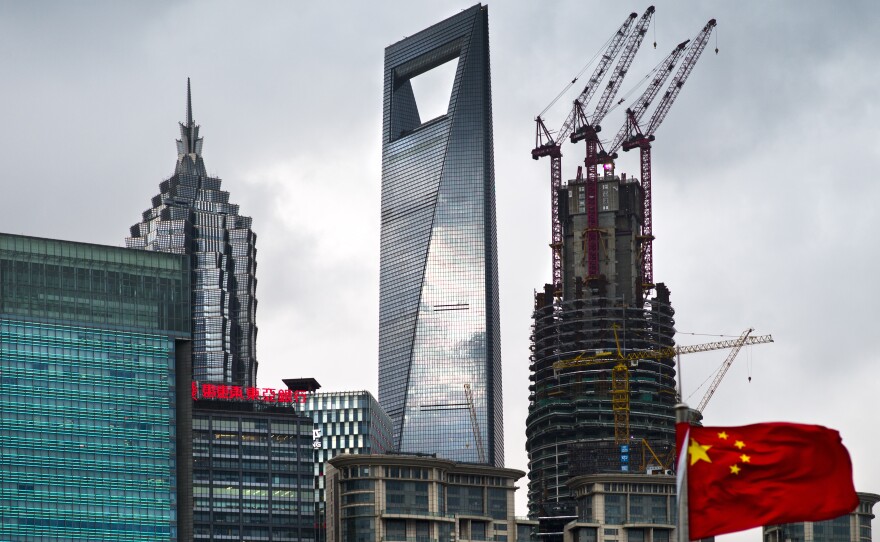Should the United States aspire to the kind of fast-paced economic growth China and India enjoy?
That's what Donald Trump seemed to say at this week's presidential debate: "I just left some high representatives in India. They're growing at 8 percent. China is growing at 7 percent, and that for them is a catastrophically low number. We are growing, our last report came out, it's right over from the 1 percent level. And I think it's going down."
But are comparisons like this meaningful?
"Comparing economic growth rates between countries at very different levels of development is absurd," says Amanda Glassman of the Center for Global Development.
For one thing, she notes, a country's growth rate — which refers to how much its total national output has increased from year to year — only tells you so much about how well off its citizens actually are. It's more illuminating to consider, for instance, a country's income per capita. It's around $6,000 in India, $14,000 in China — and $55,000 in the United States. And in India, for instance, there are vast numbers of people living in extreme poverty.
"The scale of deprivation in India is just an order of magnitude different," notes Glassman.
OK, so American workers needn't be in a rush to trade places with their counterparts in China and India. Still, wouldn't it be nice if the U.S. economy could grow at a similar rate? Sure. But the consensus among economists is that it's not possible to do so.
Poor countries are always able to grow much faster than rich ones because they're starting from a lower baseline, explains Glassman. They have "nowhere to go but up."
And to get there, they can take advantage of several drivers of economic growth that are less beneficial to rich countries, says Tamin Bayoumi of the International Monetary Fund, who is currently a senior fellow of the Peterson Institute for International Economics. Rich countries like the United States have already made use of many of these opportunities to reach their current, wealthy state. So there's less untapped opportunity to fuel further growth.
One of those drivers of growth: education. That's because, generally speaking, the more educated a worker is, the greater his or her potential to contribute to the country's economic output. In poor countries a huge share of the population is uneducated, so as more of the population becomes educated and ushered into the workforce, the country reaps huge economic gains. But those returns diminish as more of a country's workforce becomes educated.
"Let's say I'm China and I have 10 educated people per 100 of my population, versus the U.S. where I have, say 50 educated people per 100," says Bayoumi. "If I add one educated person to the pool in China I've increased the share my workforce that is educated by 10 percent. In the U.S. adding one educated person to the pool only increases the share of educated people by 2 percent."
Another way countries can grow quickly is to redirect their existing workforce into jobs where it could be more productive. A classic example: when countries shift people from rural areas, where they are peasant farmers, into urban areas, where more productive types of jobs are available, say in factories. This is a big reason for China's recent growth — and for the galloping growth that the United States and the United Kingdom enjoyed at various points during the 19th century.
"Before then, there were too many people in agriculture, so their productivity was low," says Bayoumi. "It was large families doing peasant farming." Over time, farming became more productive — allowing a smaller number of people to get the same or greater yields — and freeing up the rest to move to cities where they could engage in other work. But, again, that shift was completed in the United States ages ago, whereas it is still playing out in China and India.
So what drivers of growth are available to rich countries? Bayoumi says the United States economy largely relies on two. The first is its ever expanding pool of workers, fueled partly by a continued influx of immigrants. The second driver is incredibly important: continued improvement in the productivity of the workforce — a given worker's ability to produce more output from one year to the next. This improvement generally happens as technological innovations make workers more efficient, whether it's railroads that transport goods in the 1800s, or electricity, which made factories more efficient in the 1900s, or the ongoing tech revolution.
But even in the best of times, these drivers only increase total economic output to a limited degree. Bayoumi notes that the United States' most recent period of major growth was in the 1950s. That's when its economy benefited from the devastation World War II had wreaked on Europe's economies along with technological innovations accelerated by the war — for instance, air travel. Still, even then the U.S. economy grew at only around 2 to 3 percent a year — a far cry from China's current rate of 8 to 10 percent.
And right now, the United States may be facing an added challenge. There's concern among economists that the country has now reaped most of the gains in productivity that the tech revolution could provide. So they generally believe that, moving forward, the United States can expect annual growth rates of at most 1 to 2 percent.
"The U.S. is not going to grow at 10 percent," says Bayoumi. "Implying that we should be growing at China's growth rate is crazy. Maybe we had that in the 19th century when we were really gearing up, but it's been a very, very long time."
Copyright 2016 NPR. To see more, visit http://www.npr.org/.






